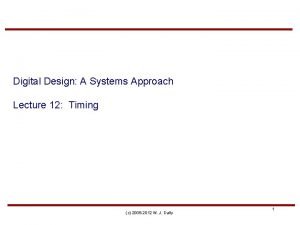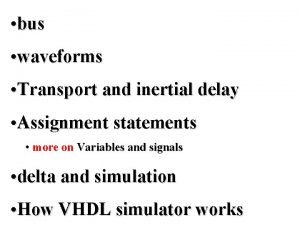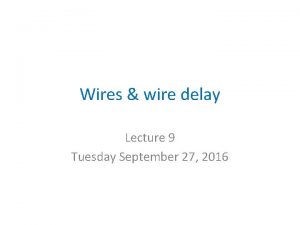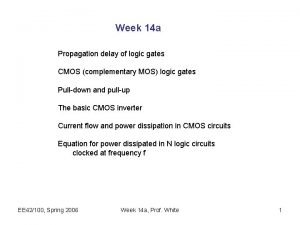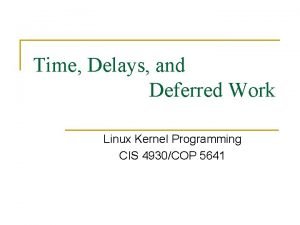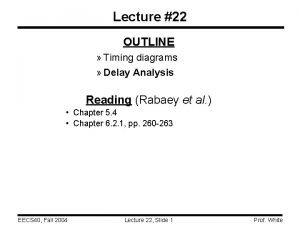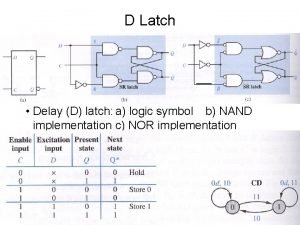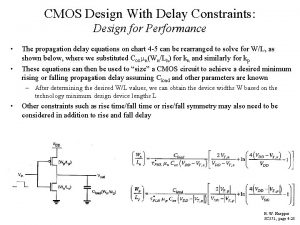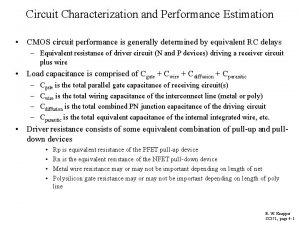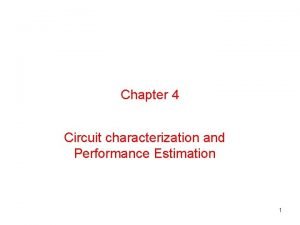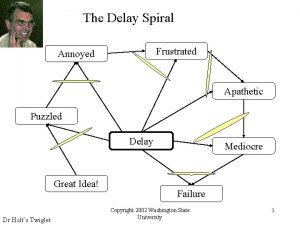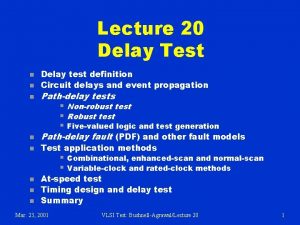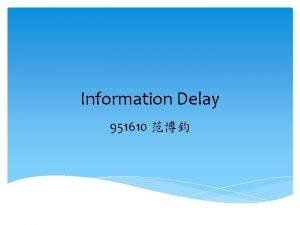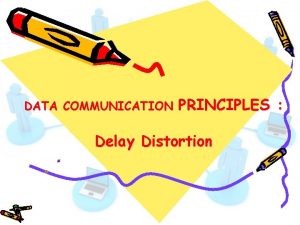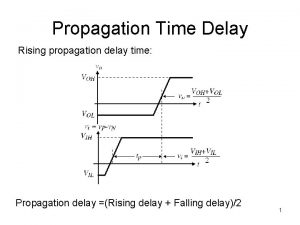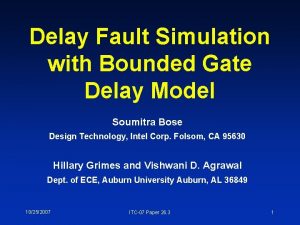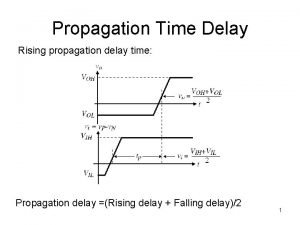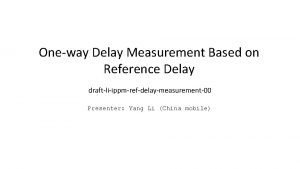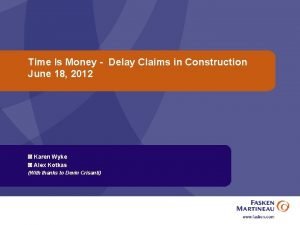5 th Annual Construction Law Summit Construction Delay
































- Slides: 32

5 th Annual Construction Law Summit Construction Delay Claim Analysis Speaker Jon Grove Berkeley Research Group

Delay Analysis Best Practices About me: Jon Grove • Over 20 years experience in the Commercial Construction Advisory Business • Specialize in Project Controls, Scheduling, Schedule Analysis • Certified as Planning and Scheduling Professional in 2010 (PSP) • Worked on every major type of construction job except Nuclear 2

Delay Analysis Best Practices Afternoons’ Objectives • Why is Delay Analysis Necessary? • What can Impact a Construction Schedule? • Steps in Performing a Delay Analysis • Summarizing the Baseline Master Schedule • Choosing a Delay Analysis method • The critical path and why it is important • Types of Delay • Finding the As-Built Critical Path • Choosing the right Analysis method • Questions to ask a Delay Expert 3

Delay Analysis Best Practices Why is Delay Analysis Necessary in Construction? 4 • Most Project Bids and Baseline Schedules are “Best Case” scenarios • Project Master Schedules are typically complex, with a lot of moving parts • Schedules and Budgets are generally impacted for multiple, overlapping reasons • Lack of strong controls in Scheduling, and Data Management • Construction is expensive and there is a lot of money at stake • A majority of Budget overruns are caused by delay related issues

Delay Analysis Best Practices What can Impact the Construction Schedule? Engineers & Architects • Poor Design • Incomplete Design • Slow Response Time 5 Owners • Excessive Changes • Delayed Approvals/ Permits • Prolonged Planning • Delayed Payment Construction Managers • Poor Planning/ Scheduling • Poor Contract Management • Coordination Issues • Unachievable Schedule • Poor Data Management • Mismanagement of Resources Contractors & Sub. Contractors Other • Unachievable Bid • Poor Productivity/ Performance • Mismanagement of Resources • Labor Shortages • Default • Unanticipated Weather • Changing Market Conditions • Unforeseen Conditions • Force Majeure

Delay Analysis Best Practices Steps in Performing a Delay Analysis 6 • Locate and Summarize the “Baseline” Master Schedule • Gain an understanding of the Planned Critical Path of the Master Plan • Gain an understanding of the intended trade flow throughout the project • Generate an As-Built Schedule • Compare the As-Planned Baseline Schedule to the As-Built Schedule • Perform a holistic review to pinpoint delayed areas/issues; try to find a theme • Review contemporaneous information to determine the As-Built Critical Path • Choose a methodology to best show your Critical Path delay • Measure Critical Path Delay to the Project over time • Determine Causation for the Critical Delay(s)

Delay Analysis Best Practices Summarizing the Baseline Master Schedule • Why is this important? • Creating a summary makes it fast and easy to understand the planned work and logic for entire project • An overall summary level makes it easier to find assign delays to specific trades • Summary levels are easier to talk about then a fully expanded nonsummarized schedule 7

Delay Analysis Best Practices Guidelines to Summarize a Baseline Schedule • Review the Schedule in its native format. i. e. Primavera, MS Project… • List all trade activities by Area/Location • Examine the Summary Baseline Schedule to understand the logic of trades and resources • Highlight the Planned Critical Path in the Summarized Baseline Schedule • Summarize the (level 2) Baseline Schedule to fit on one page for collaboration with clients and peers (level 1) 8

Delay Analysis Best Practices Level 1 Baseline Schedule 9

Delay Analysis Best Practices Level 1 Schedule 10

Delay Analysis Best Practices Level 2 Schedule 11

Delay Analysis Best Practices Level 2 Schedule 12

Delay Analysis Best Practices Choosing a Delay Analysis Technique Five Most Popular • Impacted As-Planned • Time Impact Analysis (TIA) • Windows Analysis • As-Planned vs. As-Built • Collapsed As-Built (“But For”) 13

Delay Analysis Best Practices Impacted As-Planned • Involves Insertion or addition of activities that represent delay into the baseline schedule • Used to quantify delays for contemporaneous requests for time extensions • Prospective type of analysis, to determine the likely impact of a particular event(s) • The resultant impact of the events shown on the completion date is then said to be the critical delay impact(s) 14

Delay Analysis Best Practices 15

Delay Analysis Best Practices As-Planned vs. As-Built • Identify the latest schedule update for the project • Summarize and compare the As-Built Schedule to match the Baseline Summary • If no Schedules exist. Use other project documents. Daily Reports, Site Photos, Weekly Reports, Payment applications to determine the start and finish dates matching your summary baseline schedule • Identify difference in durations and delays to start and finish dates • Identify if a particular trade is impacting and driving delays to other trades • Document all delay and verify with contemporaneous project documents using daily reports, submitted schedules, payment applications 16

Delay Analysis Best Practices 17

Delay Analysis Best Practices Time Impact Analysis (TIA) • Recommended by the Society of Construction Law Delay Disruption Protocol (SCL) for ongoing projects • Prospective (Forward Looking) and dynamic • Schedule is updated to a point in time just before the delay event • Insert delay activities as close to the status date as possible • Requires good As-Built data • Best when used during a project but questionable method of assessing a delay in post-contract dispute resolutions • Logic must be capable of correctly simulating the likely effect of the delay event • The delay events introduced in the analysis should be based only upon information known at the date of the update 18

Delay Analysis Best Practices 19

Delay Analysis Best Practices Windows Contemporaneous Analysis • Examination of the dynamic nature of the critical path from period to period • Performed retrospective but a forward-looking technique • Typically starts with the baseline schedule and proceeds from update to update, tracking progress along the critical and near critical path(s) • Requires good As-Built data • The schedules in each ‘window’ is updated to reflect the actual duration and sequence at the time of the delay while remaining as-planned schedule beyond the window period is maintained 20

Delay Analysis Best Practices 21

Delay Analysis Best Practices Collapsed As-Built (“But for”) Analysis • Retrospective technique • Begins with As-Built schedule then subtracts activities representing delays • No baseline or contemporaneous schedule updates exist or are flawed to the extent that they are not useable • Requires good As-Built data • Requires a detailed and logic linked schedule 22

Delay Analysis Best Practices 23

Delay Analysis Best Practices 24

Delay Analysis Best Practices The As-Built Critical Path and why it’s so Important • It is the longest logically connected path from the start to the completion of the project • The As-Built Critical Path typically has no float (or slack) or gaps in time and any increase in any durations on that path will impact the completion of the project • Only events that extend the duration of an as-built critical path activity will impact the completion of the project • Identifying the As-Built critical path is the single most important step in any delay analysis • Once delay(s) is identified on the as-built critical path, causation of those delays need to be attributed to the proper party 25

Delay Analysis Best Practices Types of Delay • Excusable Compensable – The Contractor was delayed and had no part in causing the delay (“Out of Contractors Control”); granted time and money for extended General Conditions, acceleration and/or impact cost • Excusable Non Compensable or Concurrent – The Contractor was equally involved/responsible for a delay, along with another party; granted time, but no money for extended General Conditions, acceleration and/or impact cost • Non Excusable Non Compensable – The Contractor was solely responsible for a delay. No money and No time granted 26

Delay Analysis Best Practices Finding the As-Built Critical Path • Review the Schedule Updates • Were Schedule updates used to actually manage the job vs just updated to show an unrealistic project completion? • Does the critical path clearly show a delay and the project completion date remains the same? • Do trades start getting ‘stacked’ up? Are there a lot of logic changes? • Do activities start to decrease in duration? • If the schedules look like it was properly updated and realistic, the critical path can be documented through the contemporaneous schedule updates and a “Windows Analysis” can be done • If the updates are questionable or outright unusable, an As-Planned vs As-Built analysis should be done 27

Delay Analysis Best Practices Determining the As-Built Critical Path • • 28 Calculation Method • Determine differences by comparing Late Dates to Actual Dates • Chart it or enter into a program to produce a Gant Chart • Compare the differences Examine Emails, Weekly and monthly meeting minutes, Daily Reports • Read, read • Document Issues • Highlight what time frames are effected

Delay Analysis Best Practices Delay Analysis Summary • Summarize your Baseline Schedule • Determine your As-Built Critical Path • Choose your analysis method • Present your findings in a simplified and easy to understand manner 29

Delay Analysis Best Practices Windows Analysis (my favorite)? • Measuring delay through different periods of time “windows” • Easily see what is critical from one time period to the next • More windows are usually always better, but to a degree. Monthly updates usually preferred • If presented correctly, it is very easy to follow and hard to discredit • Windows analysis should be done using Level 2 schedules and presented as a Level 1 Summary 30

Delay Analysis Best Practices Questions to ask a Delay Expert • Why did you choose that specific analysis method? • What are the strengths, and more importantly weakness in your chosen method? • Did you look at any schedule(s)? What where your impressions on the reliability of the schedules? • What is your favorite or most used analysis method? • When is the last time you used other methods besides your favorite? • How did you link causation to the delays? • Did you follow any industry standards? • Did you look at the contract? • Do you think this analysis makes sense? 31

Delay Analysis Best Practices THANK YOU 32
 Propagation delay
Propagation delay Assignment statement
Assignment statement Off delay timer symbol
Off delay timer symbol Construction youth summit
Construction youth summit Autism law summit
Autism law summit Newton's first law and second law and third law
Newton's first law and second law and third law Newton's first law
Newton's first law Boyle's law charles law avogadro's law
Boyle's law charles law avogadro's law Charles law constant
Charles law constant Tuesday
Tuesday Propagation delay formula
Propagation delay formula Declare_tasklet
Declare_tasklet Delay models in data networks
Delay models in data networks Ideal inverter
Ideal inverter Propagation delay timing diagram
Propagation delay timing diagram Distributed rc delay model
Distributed rc delay model How to calculate delay time
How to calculate delay time Don't delay dawns disarming display
Don't delay dawns disarming display Av node delay
Av node delay Seektime
Seektime Verilog
Verilog D latch timing diagram
D latch timing diagram Bandwidth-delay product
Bandwidth-delay product Bandwidth delay product example
Bandwidth delay product example Bandwidth-delay product
Bandwidth-delay product Time delay procedures
Time delay procedures Fan in and fan out in cmos
Fan in and fan out in cmos Propagation delay formula
Propagation delay formula Cmos
Cmos Propagation delay formula
Propagation delay formula Parking studies in traffic engineering
Parking studies in traffic engineering Elmore
Elmore A shuttle valve exhausts an air pilot of a dcv when
A shuttle valve exhausts an air pilot of a dcv when
